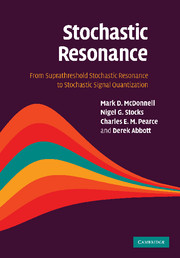Book contents
- Frontmatter
- Contents
- List of figures
- List of tables
- Preface
- Foreword
- Acknowledgments
- 1 Introduction and motivation
- 2 Stochastic resonance: its definition, history, and debates
- 3 Stochastic quantization
- 4 Suprathreshold stochastic resonance: encoding
- 5 Suprathreshold stochastic resonance: large N encoding
- 6 Suprathreshold stochastic resonance: decoding
- 7 Suprathreshold stochastic resonance: large N decoding
- 8 Optimal stochastic quantization
- 9 SSR, neural coding, and performance tradeoffs
- 10 Stochastic resonance in the auditory system
- 11 The future of stochastic resonance and suprathreshold stochastic resonance
- Appendix 1 Suprathreshold stochastic resonance
- Appendix 2 Large N suprathreshold stochastic resonance
- Appendix 3 Suprathreshold stochastic resonance decoding
- References
- List of abbreviations
- Index
- Biographies
Foreword
Published online by Cambridge University Press: 23 October 2009
- Frontmatter
- Contents
- List of figures
- List of tables
- Preface
- Foreword
- Acknowledgments
- 1 Introduction and motivation
- 2 Stochastic resonance: its definition, history, and debates
- 3 Stochastic quantization
- 4 Suprathreshold stochastic resonance: encoding
- 5 Suprathreshold stochastic resonance: large N encoding
- 6 Suprathreshold stochastic resonance: decoding
- 7 Suprathreshold stochastic resonance: large N decoding
- 8 Optimal stochastic quantization
- 9 SSR, neural coding, and performance tradeoffs
- 10 Stochastic resonance in the auditory system
- 11 The future of stochastic resonance and suprathreshold stochastic resonance
- Appendix 1 Suprathreshold stochastic resonance
- Appendix 2 Large N suprathreshold stochastic resonance
- Appendix 3 Suprathreshold stochastic resonance decoding
- References
- List of abbreviations
- Index
- Biographies
Summary
Due to the multidisciplinary nature of stochastic resonance the Foreword begins with a commentary from Bart Kosko representing the engineering field and ends with comments from Sergey M. Bezrukov representing the biophysics field. Both are distinguished researchers in the area of stochastic resonance and together they bring in a wider perspective that is demanded by the nature of the topic.
The authors have produced a breakthrough treatise with their new book Stochastic Resonance. The work synthesizes and extends several threads of noise-benefit research that have appeared in recent years in the growing literature on stochastic resonance. It carefully explores how a wide variety of noise types can often improve several types of nonlinear signal processing and communication. Readers from diverse backgrounds will find the book accessible because the authors have patiently argued their case for nonlinear noise benefits using only basic tools from probability and matrix algebra.
Stochastic Resonance also offers a much-needed treatment of the topic from an engineering perspective. The historical roots of stochastic resonance lie in physics and neural modelling. The authors reflect this history in their extensive discussion of stochastic resonance in neural networks. But they have gone further and now present the exposition in terms of modern information theory and statistical signal processing. This common technical language should help promote a wide range of stochastic resonance applications across engineering and scientific disciplines. The result is an important scholarly work that substantially advances the state of the art.
- Type
- Chapter
- Information
- Stochastic ResonanceFrom Suprathreshold Stochastic Resonance to Stochastic Signal Quantization, pp. xvii - xviiiPublisher: Cambridge University PressPrint publication year: 2008



